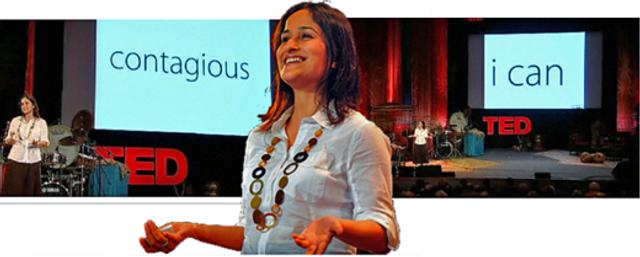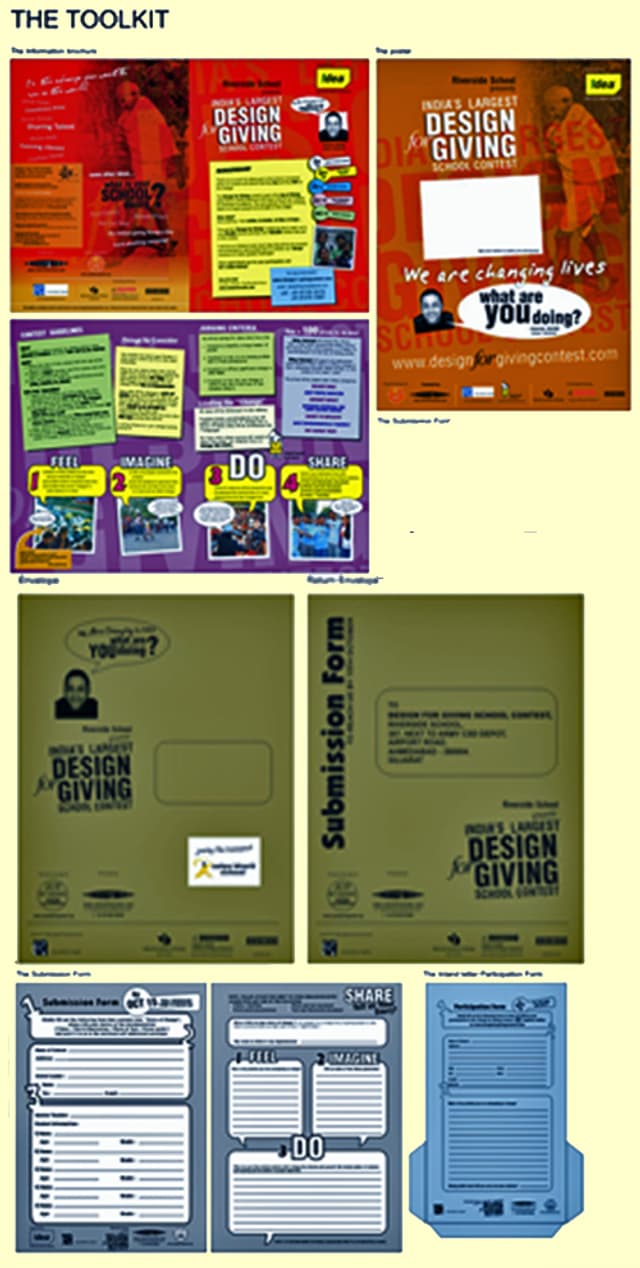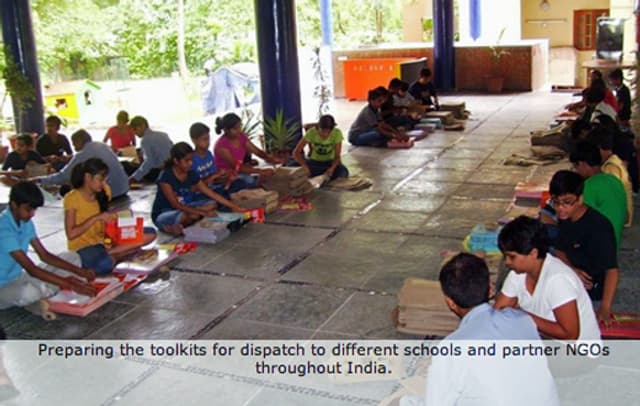Riverside School: the Design for Giving contest
- Exhibited by
- Sattva.
- Added
- June 10, 2010
- Medium of Communication
- Event
- Target Audience
- Awareness, social change campaign
- Type of Charity
- Public/society benefit
- Country of Origin
- India
- Date of first appearance
- August, 2009
SOFII’s view
Riverside School’s charismatic founder, Kiran Bir Sethi, has inspired thousands of adults and children with her belief that the ‘I can’ bug is contagious and spreads when people get together to bring about social change simply because they believe, ‘I can do that’. Here’s another inspirational initiative from Riverside School designed to encourage India’s young people to come up with solutions to the sub-continent’s great challenges.
Creator / originator
Riverside School.
Summary / objectives
As part of the Joy of Giving Week in 2009, Riverside School launched the Design for Giving contest to encourage and enable children to come up with solutions for the country’s biggest challenges. Students from across the country were asked to design a solution to a problem that they had identified was effecting their local population. They then gave a presentation of their ideas through text, Powerpoint, photos, or video.
Over 1350 schools across India, including government-aided and private schools, took part. Out of all the entries, a hundred powerful stories of change were selected for further investment and organisations across the world will work with the children to realise their ideas.
While the Joy of Giving Week was a national platform to inspire people to give, the Design for Giving Contest provided children with an opportunity to give their time and infectious enthusiasm towards finding solutions to pressing problems in their localities.
Background
In 2001, Kiran Bir Sethi started the Riverside School, in Ahmedabad, aimed at all-round development of the children. In addition to a rigorous academic focus, the school also plans a variety of programmes to help build a sense of identity and social responsibility among children. In 2008, she started an initiative called ‘AProCh’, standing for ‘a protagonist in every child’. The project aims to involve the children in the city’s activities and thus make cities child-friendly while giving them opportunities to participate and learn
Through her past initiatives, Kiran Bir Sethi has proved that if children are provided with the right opportunities and guidance, they can come up with innovative solutions to the most pressing problems in their communities. She saw Joy of Giving Week as an opportunity to scale her initiatives to a nationwide network of schools.
The Design for Giving contest reached out to students between the ages of 10 and 13 in 30,000 private, public, rural and government schools across 12 states in India. The initiative was led by Riverside School in collaboration with NGOs such as Indicorps, Manav Sadhna and Pratham Foundation, and organisations such as IDEA, Disney, Gray Matters Capital and Stanford Design School.
All the participating schools were provided with a toolkit with simple instructions. The children were asked to follow a four-step process:
- Feel – identify a problem that touches many lives that can be changed in a week.
- Imagine – talk to the people connected to the problem and generate ideas to make a difference.
- Do – implement the selected idea for a week.
- Share – present ideas as illustrated text documents, photo and text documents, PowerPoint, or videos..
The entries were then evaluated based on a variety of parameters. For instance, the jury identified entries that were the boldest, most easily replicable, most environmentally friendly, had the quickest impact, helped most people, and those that lived up to Gandhiji's values of self-reliance, humility and serving the underprivileged.
Special characteristics
- Involving children in the social change process. The Design for Giving contest stands out because its focus is on children and design. Children from all walks of life participated and worked on many diverse issues. For instance, students from the Satya Bharti School dressed up as tantriks (exorcists) to highlight the blind belief in black magic and occult practices that is prevalent in rural areas. Many of the urban schools highlighted the importance of cleanliness and responsible management of rubbish. Students from the tribal areas highlighted the widespread alcoholism among adults and the impact it has on their lives. Students from one of the schools for the hearing impaired highlighted the need for sensitivity towards children with special needs.
- Scale. The event reached out to over 30,000 schools and inspired 100,000 children to devise solutions to local problems. Riverside School achieved this by partnering with several leading NGOs working in education. For instance, Naandi Foundation in Andhra Pradesh works with over 800 schools while Pratham Foundation collaborates with more than 4000 schools in Gujarat. By partnering with these organisations, Riverside was able to scale their initiative across the country including far-flung states in north east India.
- Supporting the process. The organisers realised that the toolkits were not enough for some schools and the students were not sure how to go about the initiative. So they also conducted workshops with teachers from selected schools so that they could guide the students throughout the contest. There were also workshops for larger audiences in certain cities and towns in order to improve visibility and understanding about the contest.
- Making the most out of the initiative. The competition has helped collect rich content from children across the country. Research organisations are also looking to understand the extensive data that has been collected during the competition. For instance, Harvard’s GoodWork Project has taken up research involving the participating schools to understand the qualities of schools and school leaders to encourage and drive participation. Pratham Books (prathambooks.org) will publish stories of change in a series of books that will be translated into seven languages.
Influence / impact
Entries were invited in various languages to ensure that language did not become a barrier to participation and over 1350 schools from all over India submitted them. A hundred were chosen; 20 of these were identified as the top entries and seven received special jury mention. The top 20 entries showed a wide variety of issues ranging from spitting to speeding motorists.
Disney Outreach has promised to create play areas (with a bookshelf stacked with Disney story and activity books, board games, a Disney television and DVD player) at the 20 winning schools. In addition, they will support a hundred enthusiastic school teams in their ideas to effect change in their communities through 'Minnie grants' up to Rs. 9000/- each. However, to qualify for the grants, the students must go back to their the communities and gather feedback on their projects. The teams will use this feedback to redesign their projects to increase impact and sustainability.
Apart from the winners, any school that participated in the contest can take part in a design mentoring programme with leading design firms in India to take their projects to a higher level.
Costs
The costs of the event were predominantly around creation of the kits – documentation, printing and postage – and the event management costs, including travel, press conferences and logistics. IDEA was the lead sponsor of the event and contributed over 30 lakhs.
Amar Chitra Katha and Tinkle magazine, leading children’s magazines in India, raised awareness about the event by publishing a free advertisement.
Results
The immediate focus for the organisers is to analyse the trends and data collected in the competition this year. A panel of researchers from India and abroad has been setup to identify patterns and derive academic and actionable insights based on the information that has been collected. For instance, there is a study on the social, contextual and individual factors that had an impact on the children and how it is reflected in the problems they chose to address.
The organisers also aim to create a club or a community of children across the country to continuously foster the spirit of design and innovation among the children. And they want to provide mentoring and other opportunities as incentives for the children to be part of the club.
Riverside School aims to make this an annual event around the same time of year and thus reach as many students as possible.
Merits
The Design for Giving Contest aims to inspire children to ‘be the change that they want to see in the world (in the words of Mahatma Gandhi). Initiatives like these give children a sense of responsibility towards society and the confidence to be able to make change. It is these children who will grow up to stand for, or contribute to, a cause.
By encouraging and inspiring children, Riverside School helps build a community of socially responsible citizens who will drive and support innovations like those showcased in SOFII today.
Other relevant information
Design for Giving Contest: http://www.designforgivingcontest.com
Riverside School: http://www.schoolriverside.com

 View original image
View original image

Also in Categories
-
-






















